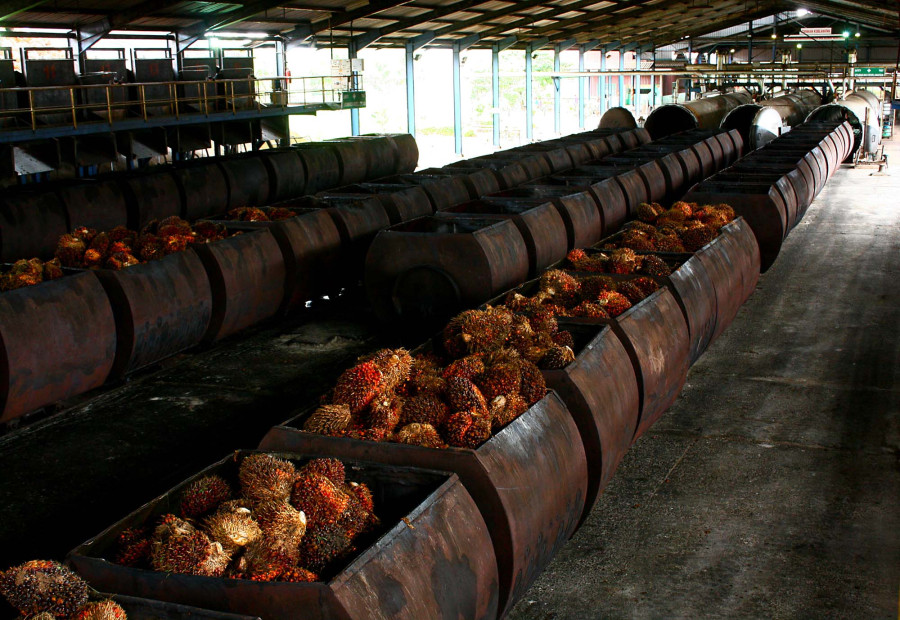Money
With the export of everything else falling, palm oil rises to the top
A smaller inventory, increased domestic consumption and a slowing Indian economy could account for the fall in exports, say experts.
Krishana Prasain
Export earnings from high-value products identified by the Nepal Trade Integration Strategy fell 6 percent year-on-year to Rs14.8 billion in the first five months of the current fiscal year as a smaller inventory and increased domestic consumption constricted foreign sales.
A slowing Indian economy could further hurt Nepal’s exports as the southern neighbour remains the largest buyer of Nepali goods, say experts.
For over a decade, Nepal’s trade performance has remained less than satisfactory, resulting in a huge trade deficit. The 2016 Nepal Trade Integration Strategy, Nepal’s third-generation trade integration strategy, has identified nine high-value products and three services to narrow the deficit.
In a twist of irony, while exports for all high-value products under the trade integration strategy fell, palm oil, which is not produced in Nepal, once again shot to the top of the list of shipments to India.
According to the Trade and Export Promotion Centre, palm oil exports rose to Rs11.5 billion in the first five months, nearly eight times the amount shipped in the same period last year.
A World Bank report attributes Nepal’s windfall in exports solely to increased demands for non-crude palm and soybean oil in India.
Tariff exemptions on Nepali exports to India under the South Asian Free Trade Area agreement gave domestic traders an incredible advantage. Countries outside of South Asia are slapped with tariffs of 54 percent on palm oil and 45 percent on soybean oil.
According to the Nepal Development Update, released by the World Bank in December, Nepal capitalised on this arbitrage opportunity and significantly increased exports of the two products.
“However, it might not be a sustainable option in the long run,” the report said.
According to the report, the export performance of products under the Nepal Trade Integration Strategy—all fabrics, textile, yarn and rope, cardamom, carpet, footwear, ginger, leather, medicinal and aromatic plants, pashmina, and tea—was dismal last fiscal year, contracting by 4.8 percent year-on-year compared with an expansion of 17.9 percent year-on-year in 2017-18.
Consequently, Nepal’s export value to GDP ratio reached 1.1 percent, markedly lower than the 4 percent target set for 2020. The key reasons for the weak performance included a lack of raw materials, skilled manpower and required infrastructure like processing centres, lab testing and storage facilities, the World Bank said.
According to Purushottam Ojha, a former commerce secretary, exports of Nepal’s high-value products declined mainly due to a fall in production.
“And there was an increase in domestic consumption, leaving little surplus for overseas sales,” he said.
As the Nepal Trade Integration Strategy’s product market is primarily India, the severe economic slowdown in the southern neighbour could also be a reason for the decline in exports, said Ojha.
Bacchu Poudel, president of the Nepal Trans Himalayan Border Commerce Association, told the Post that the competitiveness of Nepali products is eroding and as a result, exports are declining with each passing year.
“Due to a lack of inspection and quality checks, the finished product does not meet standards and struggles to compete in the international market,” said Poudel.
Shipments of pashmina, once identified as a ‘pride product’, declined by 17 percent to Rs1 billion. Domestic traders blame the fall in sales to a lack of effective branding and promotional activities in the international market.
Exports of agricultural products did not go as expected either, resulting in a decline in overall exports.
Large cardamom was the only product that performed well, with exports soaring 50.7 percent to Rs1.86 billion. Shipments of all other products—ginger, tea, medicinal and aromatic plants, fabrics, yarn, textiles, rope, leather, footwear, pashmina and carpets—were down, compared to the same period last fiscal year.
According to the centre, ginger exports slipped 14.65 percent to Rs236 million. Tea plunged 24.88 percent to Rs1.45 billion. Tea traders said that exports to the international market were stymied by a lack of organic certification.
The government provides exporters with a 5 percent cash incentive on exports of processed tea, large cardamom, ginger, leather goods, processed medicinal herbs and oil products with value addition of at least 50 percent.
According to economist Jagdish Chandra Pokhrel, the time has come to revise the list of high-value products again.
The sharp rise in exports of palm oil, which has no ‘value addition’, could largely impact Nepali farmers as it could offset the demand for Nepali products. Traders will keep exploiting easy loopholes on foreign products that yield them higher profits, said Pokhrel.
For example, the betel-nut industry in Jhapa collapsed after India banned imports in 2013. Nepali traders used to export betel nuts to India in volumes larger than what could have been possibly produced in Nepal. This meant that imports from third countries were being re-exported to the southern neighbour to take advantage of its low customs duty. Importing one tonne of betel nuts and re-exporting it to India would provide traders with a net profit of Rs 1.05 million due to custom tariff differences.
The government has been offering cash incentives on export-oriented products that provide high revenue value to minimise trade deficit. A 3 percent cash incentive is provided to exporters of pashmina, textiles, woollen carpets and yarns.
Exports of high-value products
(Mid-July to mid-December 2019)
Products2019-20Change (in %)
Fabrics and textileRs5.93 billion-7.24
Carpets Rs3.22 billion -4.04
Large cardamomRs1.86 billion50.70
Tea Rs1.45 billion -24.88
Pashmina Rs1.06 billion -17.06
HerbsRs506 million -21.32
Footwear Rs456 million -5.09
GingerRs236 million-14.65
Leather Rs109 million -33.29
Total Rs14.84 billion -5.88
(Source: TEPC)




 9.12°C Kathmandu
9.12°C Kathmandu














